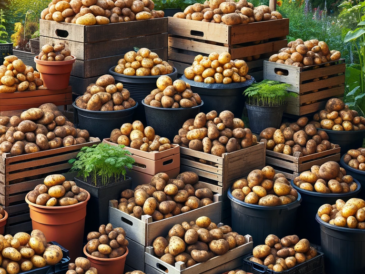Growing basil is like inviting a fragrant, flavorful friend into your garden or kitchen. Whether you want to elevate your cooking or enjoy the beauty of fresh green leaves, basil is the herb that keeps on giving! 🌱
In this beginner’s guide, we’ll uncover the secrets to growing the perfect basil plant. You’ll learn everything from seed selection to harvesting techniques that will keep your basil healthy and thriving. Whether you’re a gardening newbie or a seasoned green thumb, this guide will take your basil game to the next level!
Why Grow Your Own Basil?
There’s something magical about snipping fresh basil from your plant and adding it directly to your dish. 🍽️ Growing your own basil has tons of benefits:
- Unmatched Freshness: Store-bought basil just can’t compete with the flavor of freshly picked leaves.
- Versatility: Basil is perfect for pesto, salads, pizza, pasta, and more!
- Easy to Grow: Basil is forgiving and grows well in pots, indoors, or outside in a garden bed.
- Cost-Effective: One basil plant can give you an abundant supply, saving you money over time.
Ready to get started? Let’s dive into how you can grow perfect basil every time! 👩🌾
Step 1: Choosing the Right Basil Variety 🌱
Before you start, you need to pick the basil variety that suits your culinary needs and space. Some of the most popular types are:
- Genovese Basil: The classic variety, perfect for Italian dishes like pesto.
- Thai Basil: Spicy with a hint of anise, great for Asian-inspired recipes.
- Purple Basil: A beautiful variety with a slightly spicier taste, perfect for adding color to your garden.
Once you’ve decided, grab some seeds or a small basil plant from your local garden center.
Step 2: Planting Basil Like a Pro 🌿
For Seeds:
- Start Indoors: Basil loves warmth, so start your seeds indoors about 6-8 weeks before the last frost. Use small pots or seed trays with good drainage.
- Planting Depth: Sow the seeds about ¼ inch deep in moist, well-draining soil.
- Sunlight: Place the pots in a sunny windowsill or under grow lights. Basil needs 6-8 hours of sunlight daily to thrive.
- Watering: Keep the soil moist but not waterlogged. Mist the soil gently until the seeds sprout.
For Transplants:
- Timing: Once the danger of frost has passed, plant your basil outdoors. Make sure the soil temperature is at least 70°F (21°C).
- Spacing: Give each plant space! Basil needs 12-18 inches between plants for air circulation and growth.
- Soil Quality: Use nutrient-rich, well-draining soil to encourage strong growth.
Step 3: Caring for Your Growing Basil 🌞
Once your basil has sprouted or been transplanted, it’s time to nurture it. Follow these tips to keep it lush and healthy:
- Watering: Water your basil regularly, keeping the soil moist but not soggy. Basil prefers consistent moisture but hates sitting in waterlogged soil.
- Pruning: Pinch off the top leaves as the plant grows. This will encourage bushy growth and prevent the plant from flowering too early, which can make the leaves taste bitter.
- Fertilizing: Feed your basil every 4-6 weeks with an organic fertilizer to keep it growing strong. Avoid too much nitrogen, as it can lead to more leaves but less flavor.
Step 4: Harvesting Basil for Maximum Flavor 🍃
The best part of growing basil is, of course, the harvest! For the tastiest leaves, follow these guidelines:
- Morning Harvest: Pick your basil in the morning when the essential oils are at their peak.
- Leaf Selection: Harvest leaves from the top of the plant first. This encourages more growth and prevents the plant from getting too leggy.
- Avoid Cutting Too Much: Don’t remove more than ⅓ of the plant at once to ensure continued growth.
Step 5: Keeping Basil Fresh After Harvest 🌬️
Fresh basil wilts quickly, but here’s how to keep it vibrant:
- Store Like Cut Flowers: Place freshly cut stems in a glass of water on your countertop. This keeps them hydrated and fresh for days.
- Refrigerate with Care: Basil doesn’t love the cold. If you must refrigerate, wrap it loosely in a damp paper towel and place it in a plastic bag.
- Freeze for Later: If you have a bumper crop, freeze chopped basil in ice cube trays with olive oil for easy use later.
Troubleshooting Common Basil Issues 🧐
Even the best gardeners run into issues! Here’s how to deal with common basil problems:
- Yellowing Leaves: This could indicate overwatering or poor drainage. Make sure the soil has good drainage and adjust your watering habits.
- Pests: Aphids and spider mites love basil. Use an organic insecticidal soap or introduce ladybugs to keep these pests under control.
- Fungal Disease: Basil can be prone to fungal infections in humid conditions. Water the base of the plant rather than the leaves and ensure good air circulation.
Your Ticket to Herb Bliss 🎉
Growing basil can be an incredibly rewarding experience, whether you’re using it in the kitchen or simply enjoying its aromatic beauty in the garden. With a little love and attention, you’ll have more fresh basil than you know what to do with—and that’s a wonderful problem to have! 🌿
So, what are you waiting for? Grab your seeds, find the perfect sunny spot, and start your basil-growing journey today. Soon, you’ll be snipping fresh basil like a pro and unlocking new flavors in your cooking. Your herb bliss awaits! 🌱✨


